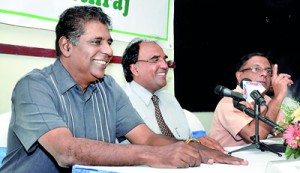Amritraj was not a minnow in a giant’s world

Vijay Amritraj (On left). - Pic by Amila Gamage
For every Lankan tennis lover from the seventies and eighties, the striking image of a tall and lanky Vijay Amritraj prowling the baseline or racing to the net for a rasping volley is as vivid a tennis memory as any they may have. For them the tenacious Indian represented the region’s principal force in tennis, frequently pressurizing, and occasionally breaking the games of powerhouses such as Rod Laver, Bjorn Borg, Jimmy Connors and John McEnroe.
Since retiring, Amritraj has become the face and voice of Grand Slam tennis to innumerable Sri Lankans who tune into live matches broadcast from Wimbledon, Roland Garros, Flushing Meadows and Melbourne Park. As a result, more recent local fans of the sport are more familiar with his laidback off-court demeanour, rather than the intensely competitive on-court spirit, which led him through a string of marathon battles across the world.
Amritraj exuded every ounce of this natural affability while speaking at the Sri Lankan Tennis Association’s headquarters last week. Paying a brief personal visit to the country, he spoke passionately and eloquently about the game’s progress and potential in South East Asia.
Filled with confidence over the talent that existed in the region, the former tennis star said that what often stalled tennis success in Asia was an inherent culture where sport is oftentimes relegated to being a “wonderful distraction”.
“The problem is that we ‘also’ play a sport; it’s not that we ‘only’ play a sport. For us it is a wonderful distraction because education is the most important thing,” he explained.
He also cited a difference in the rate of physical development between Asian players and their Western counterparts as a factor that frequently frustrated players from the region.
Amritraj exerted that players from countries like the United States, the UK and Germany matured faster as athletes than those from Sri Lanka and India, who are only able to reach this level of physical maturity in their mid to late twenties. Due to this, many Asians, upon finding themselves unable to reel off a string of impressive performances in international tournaments, move away from competitive tennis.
Nevertheless, he advised young players to remain focused, and most importantly, determined. To illustrate this point, he reached into his past vault of punishing matches and extracted perhaps his most memorable game.
In the 1987 Davis Cup semifinals, India was up against an Argentine side awash with talent and bolstered by confidence. Down 2-1, Amritraj, the team captain, stepped onto the court in New Delhi knowing that anything less than a win would seriously jeopardize India’s hopes of reaching the tournament’s final.
However, standing on the other side of the net was an equally-determined Martin Jaite, who took the match’s first two sets and sent Amritraj back into the dressing room staring defeat dead in the eye.
Yet for Amritraj, who had by then reached the twilight of his career, surrender was not an option, despite fervent calls by his Davis Cup teammates to throw in the towel. Remarkably the Indian, whose trainer said had lost 11 pounds in weight and was at risk of seriously endangering his health, continued to battle and claimed the next two sets. He eventually moved on to spectacularly win the match 3-6, 3-6, 6-4, 8-6, 6-2 and propel his country into its second Davis Cup finals.
This game was but one among a long line of epics, the most storied of which is a five-set thriller against the great Bjorn Borg at the 1979 Wimbledon. Up two sets and 4-1 in the fourth, Amritraj was to lose the match 2-6, 6-4, 4-6, 7-6, 6-2 due to what he describes as a freak reflex reaction from Borg at the net, which snatched the game’s momentum from his clutches.
Nevertheless, Amritraj can speak of a career embedded with two quarterfinals appearances at tennis’ ultimate spectacle, something precious few others can boast of.
“I always say there is nothing second to playing on Centre Court at Wimbledon. I don’t mean no second in our sport. I mean no second in general or anything that comes close to being on that court at Wimbledon. It’s just me and you, in a prime location, which is absolutely the mecca of tennis, and that’s unique, and something I have never felt in any walk of life,” he reveals.
For Amritraj, the glory of Wimbledon and the joy of the Davis Cup invoke two distinct feelings that are yet strangely connected.
“They are different yet similar. Different in the fact that when you play Davis Cup they don’t mention your name. They say game India. Game Sri Lanka. So that makes a big difference to what goes into your head. To a great extent it brings out the best in you because you feel like you have let the country down. But in Wimbledon I was doing it for India and not myself, even though they said my name.”
As a player who battled the best of a previous generation of tennis stars, and as a sports commentator who analyses the stars of today, Amritraj is perhaps best placed to answer the question of what really separates the great from the good. His answer: “What’s between the ears.”
“The most important thing is mental capability. You can talk about tactics, strategy and so on but it comes down to mental toughness and physical ability. Look at the way Djokovic worked before he actually made the breakthrough. The greatest achievement of these guys is how they have been consistently able to be the best over the last 24 or 36 months. You’ve done everything, you have all the money you need, so what keeps you at the top? It’s what’s between the ears. “
Follow @timesonlinelk
comments powered by Disqus



























